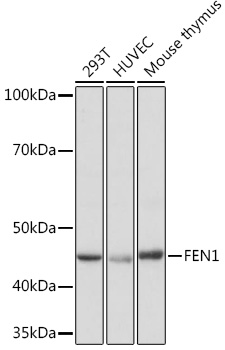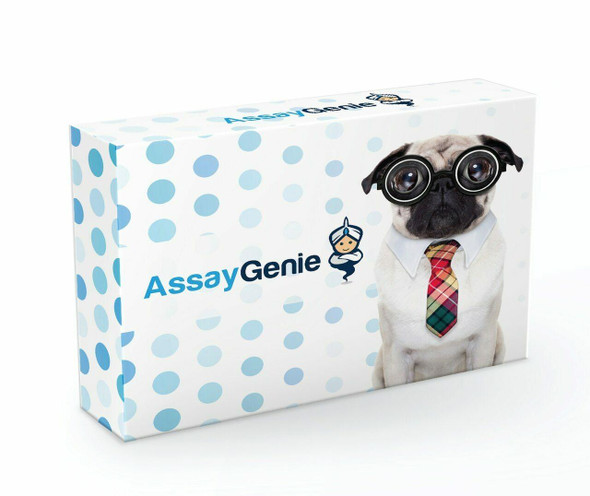Anti-FEN1 Antibody (CAB8999)
- SKU:
- CAB8999
- Product type:
- Antibody
- Reactivity:
- Human
- Mouse
- Host Species:
- Rabbit
- Isotype:
- IgG
- Antibody Type:
- Monoclonal Antibody
- Research Area:
- Epigenetics and Nuclear Signaling
Description
| Antibody Name: | Anti-FEN1 Antibody |
| Antibody SKU: | CAB8999 |
| Antibody Size: | 20uL, 50uL, 100uL |
| Application: | WB IHC |
| Reactivity: | Human, Mouse |
| Host Species: | Rabbit |
| Immunogen: | A synthesized peptide derived from human FEN1 |
| Application: | WB IHC |
| Recommended Dilution: | WB 1:500 - 1:2000 IHC 1:50 - 1:200 |
| Reactivity: | Human, Mouse |
| Positive Samples: | 293T, HUVEC, Mouse thymus |
| Immunogen: | A synthesized peptide derived from human FEN1 |
| Purification Method: | Affinity purification |
| Storage Buffer: | Store at -20°C. Avoid freeze / thaw cycles. Buffer: PBS with 0.02% sodium azide, 0.05% BSA, 50% glycerol, pH7.3. |
| Isotype: | IgG |
| Sequence: | Email for sequence |
| Gene ID: | 2237 |
| Uniprot: | P39748 |
| Cellular Location: | |
| Calculated MW: | 42kDa |
| Observed MW: | 45KDa |
| Synonyms: | FEN-1, MF1, RAD2 |
| Background: | The protein encoded by this gene removes 5' overhanging flaps in DNA repair and processes the 5' ends of Okazaki fragments in lagging strand DNA synthesis. Direct physical interaction between this protein and AP endonuclease 1 during long-patch base excision repair provides coordinated loading of the proteins onto the substrate, thus passing the substrate from one enzyme to another. The protein is a member of the XPG/RAD2 endonuclease family and is one of ten proteins essential for cell-free DNA replication. DNA secondary structure can inhibit flap processing at certain trinucleotide repeats in a length-dependent manner by concealing the 5' end of the flap that is necessary for both binding and cleavage by the protein encoded by this gene. Therefore, secondary structure can deter the protective function of this protein, leading to site-specific trinucleotide expansions. [provided by RefSeq, Jul 2008] |
| UniProt Protein Function: | FEN1: Structure-specific nuclease with 5'-flap endonuclease and 5'-3' exonuclease activities involved in DNA replication and repair. During DNA replication, cleaves the 5'-overhanging flap structure that is generated by displacement synthesis when DNA polymerase encounters the 5'-end of a downstream Okazaki fragment. It enters the flap from the 5'-end and then tracks to cleave the flap base, leaving a nick for ligation. Also involved in the long patch base excision repair (LP-BER) pathway, by cleaving within the apurinic/apyrimidinic (AP) site-terminated flap. Acts as a genome stabilization factor that prevents flaps from equilibrating into structurs that lead to duplications and deletions. Also possesses 5'-3' exonuclease activity on nicked or gapped double- stranded DNA, and exhibits RNase H activity. Also involved in replication and repair of rDNA and in repairing mitochondrial DNA. Interacts with PCNA. Three molecules of FEN1 bind to one PCNA trimer with each molecule binding to one PCNA monomer. PCNA stimulates the nuclease activity without altering cleavage specificity. The C-terminal domain binds EP300. Can bind simultaneously to both PCNA and EP300. Interacts with DDX11. Belongs to the XPG/RAD2 endonuclease family. FEN1 subfamily. |
| UniProt Protein Details: | Protein type:Nucleolus; EC 3.1.-.-; Nuclear receptor co-regulator; DNA repair, damage; Ribonuclease; DNA-binding; Deoxyribonuclease Chromosomal Location of Human Ortholog: 11q12 Cellular Component: membrane; mitochondrion; nuclear chromosome, telomeric region; nucleolus; nucleoplasm; nucleus; plasma membrane; protein complex Molecular Function:5'-3' exonuclease activity; 5'-flap endonuclease activity; damaged DNA binding; DNA binding; double-stranded DNA binding; double-stranded DNA specific exodeoxyribonuclease activity; endonuclease activity; exonuclease activity; protein binding; ribonuclease H activity Biological Process: DNA repair; DNA replication; DNA replication, removal of RNA primer; double-strand break repair; double-strand break repair via homologous recombination; telomere maintenance via recombination; UV protection |
| NCBI Summary: | The protein encoded by this gene removes 5' overhanging flaps in DNA repair and processes the 5' ends of Okazaki fragments in lagging strand DNA synthesis. Direct physical interaction between this protein and AP endonuclease 1 during long-patch base excision repair provides coordinated loading of the proteins onto the substrate, thus passing the substrate from one enzyme to another. The protein is a member of the XPG/RAD2 endonuclease family and is one of ten proteins essential for cell-free DNA replication. DNA secondary structure can inhibit flap processing at certain trinucleotide repeats in a length-dependent manner by concealing the 5' end of the flap that is necessary for both binding and cleavage by the protein encoded by this gene. Therefore, secondary structure can deter the protective function of this protein, leading to site-specific trinucleotide expansions. [provided by RefSeq, Jul 2008] |
| UniProt Code: | P39748 |
| NCBI GenInfo Identifier: | 729475 |
| NCBI Gene ID: | 2237 |
| NCBI Accession: | P39748.1 |
| UniProt Related Accession: | P39748,AAB32522 |
| Molecular Weight: | 35,673 Da |
| NCBI Full Name: | Flap endonuclease 1 |
| NCBI Synonym Full Names: | flap structure-specific endonuclease 1 |
| NCBI Official Symbol: | FEN1 |
| NCBI Official Synonym Symbols: | MF1; RAD2; FEN-1 |
| NCBI Protein Information: | flap endonuclease 1 |
| UniProt Protein Name: | Flap endonuclease 1 |
| UniProt Synonym Protein Names: | DNase IV; Flap structure-specific endonuclease 1 |
| UniProt Gene Name: | FEN1 |
| UniProt Entry Name: | FEN1_HUMAN |






